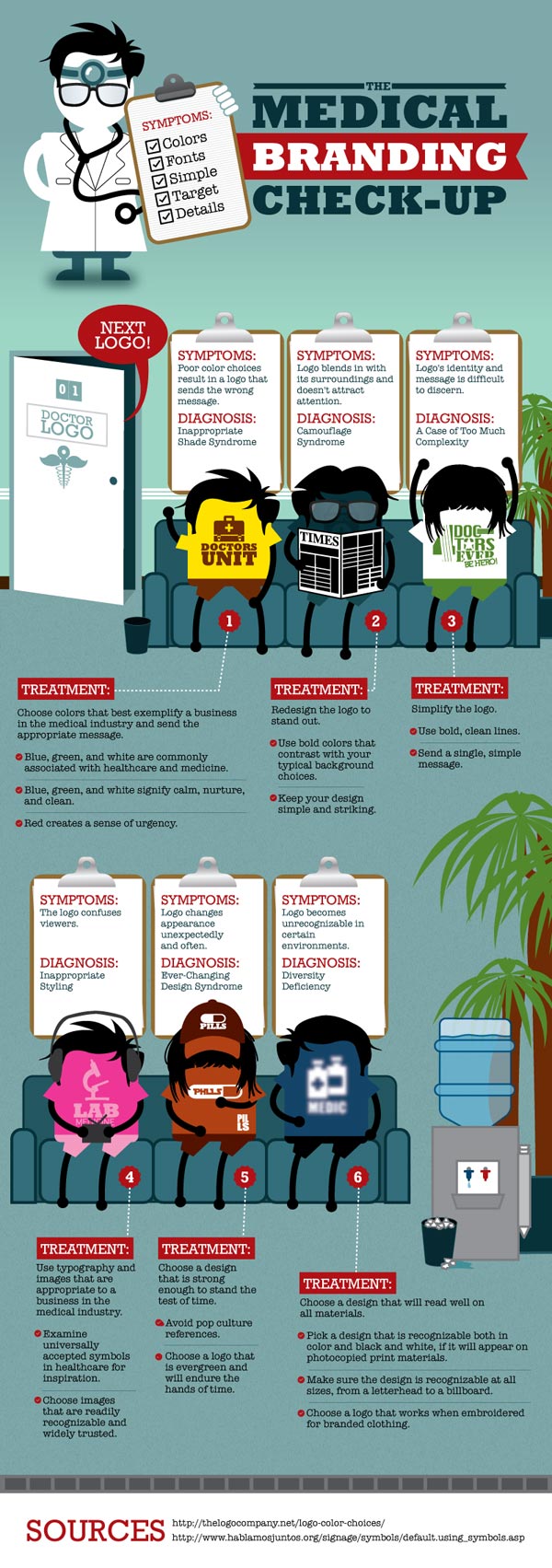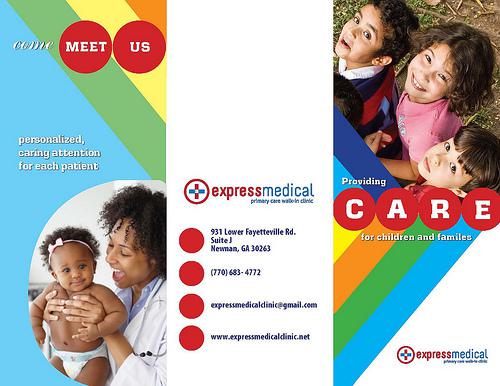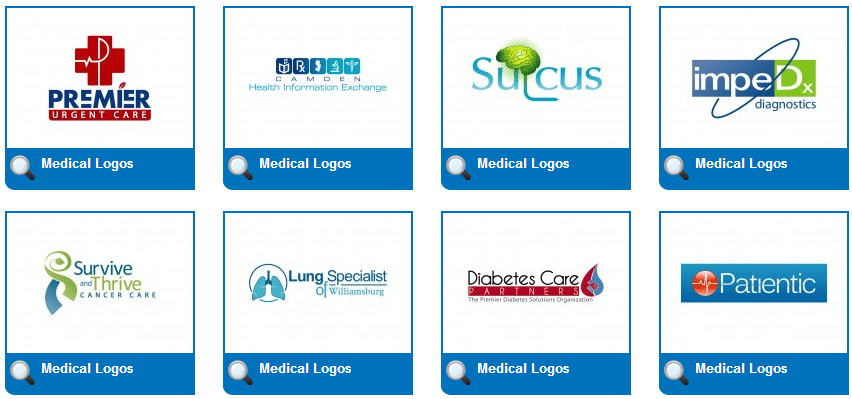Developing a Healthy Medical Branding Strategy
What You Need to Know to Make Your Medical Industry Brand Guide a Success
You need a medical industry brand guide to best promote and succeed with in the medical industry. “Brand” is a word that’s thrown around a lot, but many companies don’t realize what this key term really means. Building a successful brand in the medical industry is a complex process that involves everything from your writing to your web site. With a strong brand, you will enjoy word of mouth promotion and lasting loyalty that goes beyond the success of any one marketing campaign.
Medical Brand Infographic: Bad Brand? Symptoms, Diagnosis, Treatment!

Does your medical brand need a health check? Don´t make these terminal errors when designing your logo.
Understand What is a Medical Industry Brand Guide
Branding is easily confused with marketing, but the two are actually very different. Your medical industry brand guide is the identity of your company. It’s comprised of everything from your medical logo design to the language in your materials to the way your representatives answer the phone. While certain elements of a brand are tangible, like the colors in your logo or the imagery on your website, others are more ephemeral, like the way your staff treats patients.
As you’re creating your medical industry brand guide, it’s important to realize that what you put forth as your brand is open to interpretation by the customer. Your brand as it exists in the mind of the customer will vary from one person to the next. Your job is to try and create a sense of continuity and consistency that can overpower the differences in perception. After all, the most successful brands enjoy a fairly consistent perception. Provideing customers with a stable look and feel that they will immediately recognize when they come across it.
The following medical industry brand guide elements will help you create a complete medical brand that will help you meet your business goals and build customer loyalty. Keep in mind that creating your brand comes before any marketing efforts. However, you will go through many different marketing campaigns over the coming months and years. But your brand should stay the same so customers can easily recognize who’s behind the advertisement, no matter what approach you’re taking to your current marketing campaign.
Pinpoint Your Medical Industry Brand Goals

Image via Flickr by Daniel Oines
Defining your goals is the first step toward creating a successful and recognizable medical industry brand guide. If you don’t know what you’re about, you can’t expect anyone else to. It’s best to choose goals that are detailed. It is much easier to excel in a niche sector than to dominate a broad category.
Consider your primary medical focus. Are your patients primarily children, women, families, the elderly, or some other unique segment? What type of care do you provide? Surgical care, preventive medicine, hospital care, and maternity services are all very unique areas that will lend toward distinctly different brands.
Select one or two qualities that you want to highlight the most within your area. Put them down in your medical industry brand guide. Don’t strive to brand yourself as the very best at everything. You’ll likely come off as overconfident at best and unrealistic at worst. You might focus on short wait times, innovative procedures, or comfortable facilities, as a few examples.
Define Your Medical Industry Brand Market Segment
Create a picture of your typical customer, client, or patient and add as much detail as possible, so you can cater to this person in a personalized manner. Put together three or four profiles of fictional people who embody the typical personalities that you deal with. If you’re promoting a family practice, you may want profiles for an infant, toddler, child, and parent. Other segments may focus on the elderly, catering to both the aging patient and the concerned children who coordinate care for their parent.
Furthermore, medical companies also need to consider whether they are primarily selling their products and services to patients or to doctors. If you’re marketing new medical technology or prescription medications, you have the dual job of winning over patients who will want to try your products and convincing doctors that you have something worth their recommendations.
Build A Clever Medical Industry Brand Guide
As you’re looking your market segment in the face, think of ways you can build a brand that will appeal directly to it. What’s at the forefront of the customer’s mind as he’s shopping for health care products or services? Is your target audience itching to try out new medical technology, or is he reserved about innovative procedures? Strive to build your medical industry brand guide in a way that will answer questions and allay concerns as quickly as possible.
Send the Right Medical Industry Brand Guide Message

Image via Flickr by Mike Curwen
Now that you’ve determined who you’re talking to, you can decide what you want your brand to say. If you’re appealing to patients and not doctors, keep your message and terminology simple. More than a third of the participants in a 2003 survey by the National Center for Education Statistics had a basic or below basic level of health literacy.
Gender, age, and race all impact average health literacy scores as well. Only three percent of seniors age 65 and over had proficient health literacy, while 16% of people age 25 to 39 were considered proficient. Make sure your materials are written at a level your customers can understand.
Happy Medical Industry Brand Guide Images
Companies in the medical industry must also take care to avoid morbidity in their brand message. You may deal exclusively with terminal patients, but your medical industry brand guide should still steer clear of imagery or messages that will put the patient in mind of dark or depressing thoughts. Instead, promote a sense of calm and peace.
Finally, make sure your message is clear. Don’t clutter your brand up with too much text and research. When you’re building a brand, it’s important to stay concise. A simple focus like fast emergency services, comfortable hospital suites, or the latest technology in heart health, is the easiest way to promote your business.
Design a Standout Medical Logo For Your Brand
Your logo is one of the most important unifying elements of your brand. This logo will appear on all your materials, from your letterhead to the applique on your lab coats. Keep your logo design clean and simple so it’s easily recognizable in all its forms. Clear lines and an understandable imagery are important in a health care logo. Some more examples can be looked at in our logo portfolio.

Hablamos Juntos has created a set of universal health care symbols meant to eliminate language barriers in health care settings. These images can provide inspiration for your own logo. Viewers must immediately identify any imagery you use in your logo for it to be successful.
The colors that you use in your logo have an impact on the message you send as well. Some common associations that are important to the healthcare industry include:
Red: Urgency, warmth, emergency services
Green: Natural, organic, nurturing, calming, educational
Blue: Cleanliness, professionalism, calming
It’s no coincidence that these colors are so prevalent in the healthcare industry. Seeing them evokes certain feelings and connotations that are beneficial to the medical industry brand guide message you are trying to send.
Create a Recognizable Medical Industry Brand Guide

Image via Flickr by Kaz Andrew
With your logo and brand message in hand, you can begin to build out to create a recognizable brand. Think of all the places that your medical industry brand guide is evident, and create a plan for incorporating your brand image into each one. Remember that your brand is not exclusive to your marketing materials. Your office, employee attire, and web page all contribute to your brand as well.
Every patient experience will contribute to the way people perceive your brand. A clean logo and catchy message will fail you if patients find a disorderly office, confusing web page, and unprofessional staff. Every interaction that a customer has with your company ultimately becomes a part of his experience with the brand, and thus his idea of what your brand means.
Define the ideal experience of each of your previously created customers for a better idea of how you want to build on your brand. What kind of greeting does he get when he walks into the office? What literature will he receive when he tries your product for the first time? If he’s dissatisfied and seeks further help, what will he encounter at each point along the way? Every interaction is a chance to strengthen your brand image.
Use Your Website to Further Your Medical Brand
The Internet is becoming increasingly popular as a source of reliable health information. A Pew Internet survey found a lot of interesting new facts of 2023. An online presence is almost mandatory for success in today’s tech-minded environment.
You can use your website to further your medical industry brand guide in many ways. Offer engaging tools that highlight your brand and inform your customers. A pediatric practice can offer learning resources for kids that make health information fun and accessible at a young age. New tools and technology are often easier to understand when information is accompanied by videos, pictures, and other forms of engaging media.
Health care practices can connect with patients through the site. Providing professional and courteous interactions online will build your brand image as friendly and approachable. Innovative online features like patient profiles and online appointment making can also enforce your brand image as high-tech and trendy.
Express Brand Identity Through Employees

Image via Flickr by iMorpheus
Every employee in your company is a part of your brand. This is especially true of employees who have regular contact with your customers or patients. It’s important to recognize all the ways a single person can impact your brand. The beauty of your marketing materials is lost if your patients are greeted rudely in the office, or your representatives seem too rushed to take the time to answer someone’s questions.
Train everyone in the company to meet your standards. Develop a clear curriculum that you will use with every employee to ensure consistency. This is particularly important if you’re operating multiple locations. If you’re branding your hospital chain as the utmost in comfort and courtesy, patients should get the same friendly greeting and package of amenities at every location.
Small touches can make a big difference when you’re extending your branding to employees. Consider little details like custom lab coats that make your doctors stand out. Patients will quickly come to recognize that little difference, and anticipate a certain level of care from your professionals. Whether they welcome the appearance of the branded coat or shy away from it is all a matter of following through and acting in a way that supports the brand you’re building.
Cater the look of your employee coats or badges to the clients you have defined. Seniors will appreciate a different demeanor than what children clamor after. Fun buttons and colorful extras are best for kids, while adults may take more comfort from a subdued and stable environment.
Add Unique Extras For Your Medical Industry Brand Guide
The final step in solidifying your brand is tacking on those little extras that will make such a big difference to your customers. Consider whether the use of smart promotional materials can help support your brand image. A free pen is great, but it probably won’t help you stand out from your competitors. More useful items like a portable first aid kit at the beginning of the busy summer months, or pampering lotions and massage oils for new moms will stand out more.
You can also keep your brand at the forefront of the customer’s mind by following up often. Send thank you notes, get well notes, holiday cards, or healthcare reminders. Add a personal touch, like signatures of the patient’s health care team in these cards. Going above and beyond is the best way to enforce a medical brand as one that’s truly concerned with the patient’s health and not just the bottom line.
Whether you’re sending a roll of stickers home with a child, or providing comprehensive health care literature to concerned caregivers of an ailing patient, it’s the places where you can go above and beyond that will make your brand most memorable.
Your medical industry brand guide is ultimately the culmination of all the important parts and pieces that go into it, from your logo and message, to your interactions with the client. A successful brand takes time to build, since much of its success will come with repeated positive experiences with the customer. Stick with your brand and create an image you’ll continue to use for the long haul to get the most out of your branding efforts.
